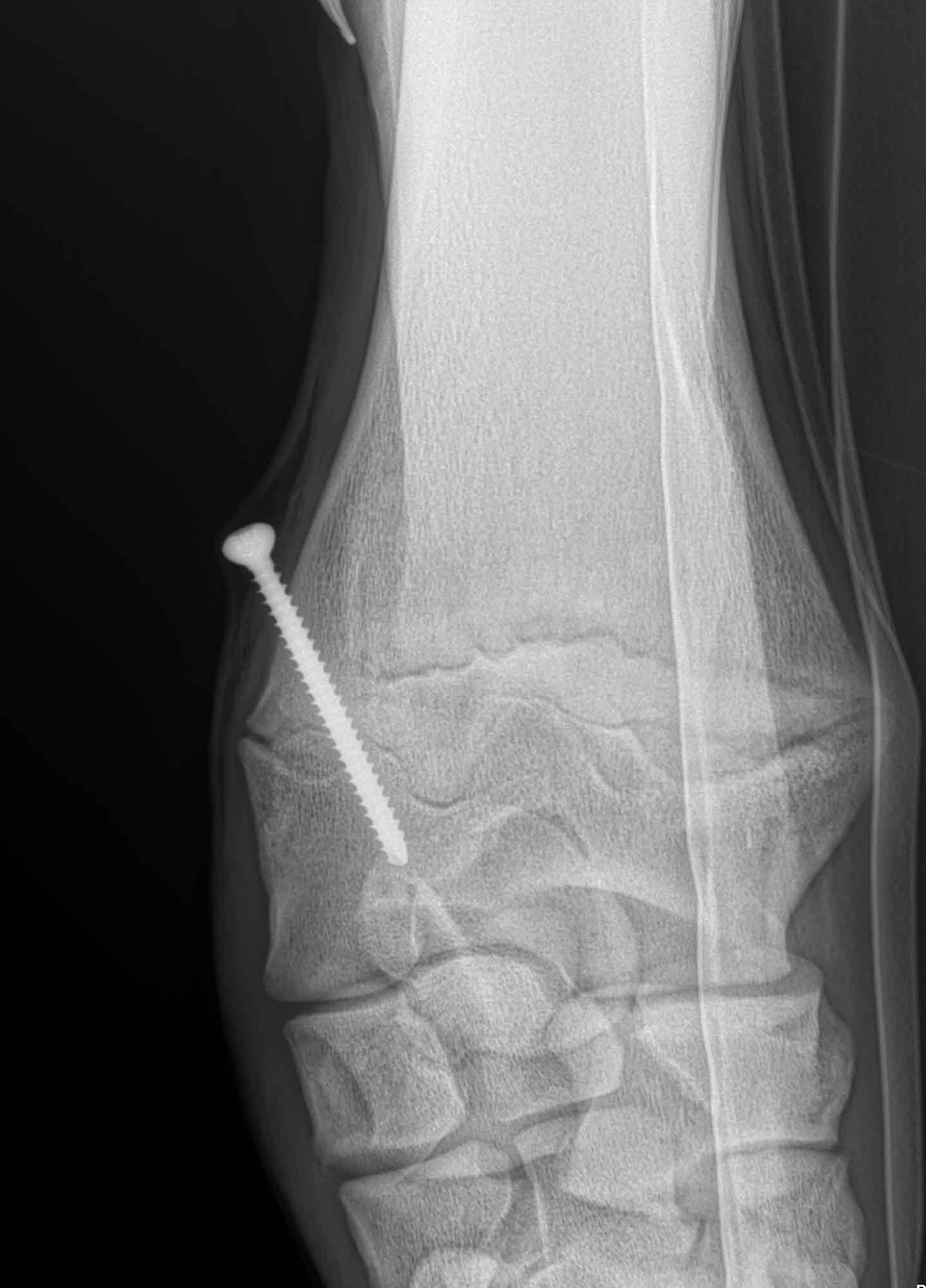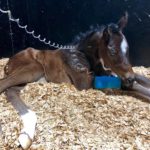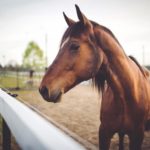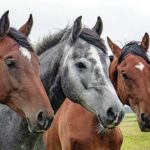In our last bog post we reviewed the importance of strong immunity in newborn foals. Healthy foals also need strong, well conformed legs for successful growth and an ability to withstand the rigours of riding or competition.
This article will describe some of the terms and more common conditions seen, as well as outlining current treatment options.
Deformities may be classified broadly as angular limb deformities or flexural limb deformities. They may be evident at birth, or develop as the foal matures.
Angular Limb Deformities
Angular limb deformities are best viewed and assessed from the front and while the foal is walking. The most frequent presentation we see are knock-knees (called valgus deformity), originating from problems of the distal radius growth plate, or toe- in (varus) deformities of the fetlock, originating from the distal cannon growth plate. Figure 1 shows a young foal with valgus limb deformity.

Fig 1 valgus deformity of a young foal, which was successfully corrected with surgery.
Longitudinal growth originates from growth plates at both ends of long bones. If one side closes relative to the other then angular limb deformities may result. Underlying causes can vary from incomplete ossification of bones in utero, joint laxity, imbalanced nutrition after birth, excessive exercise or trauma. Genetics can also play a role, so the mare and stallion’s conformation is important also.
Conservative management: Many mild or moderately affected foals respond well to stall rest and corrective hoof trimming (with or without hoof wall extensions- Figure 2). Foals shouldn’t be confined in boxes long term, so when correction becomes apparent exercise should be provided in larger yards or small paddocks. As a general rule we do not recommend bandaging or splinting of angular deformities due to the risk of pressure sores or flexural deformities developing.

Fig 2 Plastic or aluminium foal shoes
Surgical management
Surgery is best undertaken before the growth plate closes. The ideal age varies depending on which joints are affected as the various growth plates close at different times e.g. fetlock growth plates close within a few months, while carpal growth plates don’t close until the horse is nearly 2 years old.
Periosteal stripping is a procedure where a small incision is made above the affected growth plate. Stripping is a “growth promotion” procedure as it stimulates various chemicals associated with growth plate activity. Transphyseal bridging is another surgical procedure that is the favoured option for severe angulation or can be used when stripping or conservative treatment has failed. Bridging can be achieved with staples, screws or wires and is a “growth restriction” procedure, slowing down activity on one side of the growth plate so the other side can ‘catch up’.
Cosmetic results for both surgical procedures are usually good. Figure 3 shows an x-ray of a single bridging screw in a foal with an angular deformity.
A short surgical procedure is required to remove screws when correction has occurred. A review of race horses that have undergone corrective surgeries as foals showed there is no difference in racing performance compared to normal horses.

Fig 3 A bridging screw in place to correct and angular deformity
Flexural limb deformities
Hyperflexion (contracted tendons) occurs when a tendon is too short relative to the associated bones and joints. Hyperextension or tendon laxity, in contrast, are due to muscle or tendon weakness. Flexural deformities are best viewed from the side.
Foals may be born with flexural deformities or they can be acquired. Their causes are mostly poorly understood but may include uterine malpositioning, nutritional deficiencies, trauma or systemic illnesses. Club feet, fetlock contraction and knee contraction are the most common flexural deformities seen at our clinic, all of which involve the flexor tendons that run down the back of the legs.
Management
There are a number of different management options available depending on the location and severity. These can include combinations of exercise restriction, bandaging, splints, casts, corrective shoeing, nonsteroidal anti-inflammatory drugs, oxytetracycline therapy and surgery.
Prompt veterinary treatment is advised in these patients. It is not uncommon to see more than one type of tendon problem in a particular foal, as well as other health problems. It is important to correct hyperflexion abnormalities as soon as possible after birth to prevent other issues developing. Foals that are being treated with casts and splints in particular need to be monitored carefully.
Tendon laxity will improve in the majority of foals over the first few days of life. Gentle, controlled exercise is needed to strengthen muscles and tendons, but not so much the foal becomes exhausted. We occasionally apply bandages to protect the back of the heels from developing pressure sores, but bandages should not extend over any joints, as these will worsen the hyperextension.
Some flexural deformities respond well to surgical procedures. Club foot conformation often doesn’t become apparent until a foal is several months old and can be managed with check ligament surgery and/or corrective farriery.
In summary
Remember that a degree of angulation of fetlock or knees is normal in many foals, which will correct as the foal grows. Controlled exercise and appropriate foot trimming are also very important. Some foals will require surgery. Assess foals and start hoof trimming (in close consultation with your vet and farrier) from three weeks of age unless the deformity is obviously severe or present at birth when treatment may be required earlier. The best results always come from teamwork between an observant and diligent owner, and vet and farrier experienced with working on foals.
This article first appeared in Horse Deals Magazine Sept 2016. Remember- the team at Darling Downs Vets are always willing to answer your call if you have any questions about angular limb deformities or any other issue!




